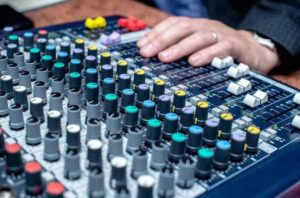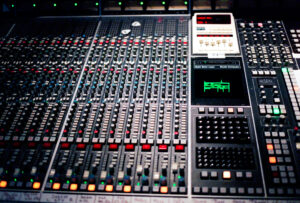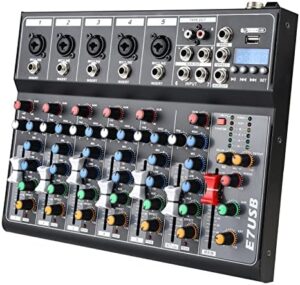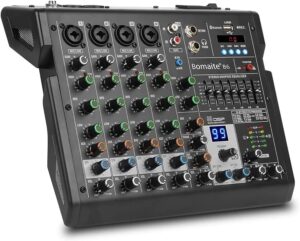Welcome to our in-depth exploration of the world of professional audio mixers. Just as a conductor skillfully orchestrates a symphony, an audio mixer serves as the maestro behind every memorable sound production.
In this article, we will delve into the intricacies and nuances of professional audio mixers. These powerful devices bring together various audio signals, allowing us to harmoniously blend music, dialogue, and sound effects with precision and finesse.
As we embark on this journey, we will uncover the purpose and importance of an audio mixer, understand its fundamental components, and explore how it operates to create seamless auditory experiences. We’ll also discuss the crucial role that balanced output plays in achieving pristine sound quality.
Furthermore, we will unravel the different types of audio mixers available today and examine their specific functions in both recording studios and broadcast productions. Alongside these insights, we’ll touch upon common challenges faced by audio professionals in their mixing endeavors.
Lastly, we will shed light on exciting career opportunities within the field of audio mixing that await those who are passionate about shaping sonic landscapes. So let’s dive right in and discover what makes a professional audio mixer truly exceptional!
Key Takeaways What Is A Professional Audio Mixer?
- Professional audio mixers combine and adjust multiple audio signals to create a balanced and cohesive output.
- Signal processing tools like equalization, compression, and effects enhance the sound quality and shape the tonal characteristics, dynamics, and spatial aspects of the audio signal.
- Different types of audio mixers include digital mixers, which use digital signal processing and offer features like built-in effects and precise control over channels, and analog mixers, which use analog circuitry and have a warm and natural sound quality.
- Audio mixers are used in various settings such as live performances, recording studios, and broadcasting.
The Purpose of a Professional Audio Mixer
Get ready to discover the true magic behind a professional audio mixer and how it enhances sound like never before!
A professional audio mixer serves the purpose of combining and adjusting multiple audio signals to create a balanced and cohesive output. It achieves this through input channel routing, which allows for precise control over each individual source. This routing capability enables the audio engineer to determine which signals are sent to specific channels, allowing for seamless integration of various instruments or microphones.
Additionally, a professional audio mixer incorporates signal processing tools such as equalization, compression, and effects to enhance the sound quality further. These tools help shape the tonal characteristics, dynamics, and spatial aspects of the audio signal.
Understanding these components is essential in harnessing the full potential of an audio mixer.
Now let’s delve into understanding the components of an audio mixer without delay.
Understanding the Components of an Audio Mixer
In this discussion, we’ll explore the components of an audio mixer. We’ll focus on three key points:
- Input channels and controls: These are responsible for managing the audio signals coming into the mixer from various sources.
- EQ and effects: These allow us to shape the sound by adjusting frequencies and adding creative effects.
- Mixing and output controls: These provide us with the ability to blend multiple audio sources together and route them to different destinations.
By organizing the information in this way, we can clearly understand each concept and its role in an audio mixer.
Input Channels and Controls
Use the faders and knobs on the audio mixer to adjust the input channels and controls, allowing you to finely tune the sound levels and effects.
The control layout of an audio mixer typically consists of multiple input channels, each with its own set of controls. These controls include gain knobs, which adjust the volume level of each channel’s input signal. Additionally, there are pan knobs that determine the placement of a channel’s sound in the stereo field, allowing for precise positioning. Other important controls include solo buttons, which isolate individual channels for monitoring purposes, as well as mute buttons for temporarily silencing specific channels. By manipulating these various controls, audio engineers can achieve precise control over their audio mix. Moving forward into our next section about ‘eq and effects,’ we will explore how these features further enhance your ability to shape your sound.
EQ and Effects
To truly refine your sound, you’ll want to delve into the realm of equalization and effects. EQ techniques are essential for shaping the tonal balance of each input channel. With an audio mixer, you can adjust frequencies to boost or cut certain ranges, such as bass or treble. This allows you to enhance the clarity and presence of individual instruments or voices in your mix.
Additionally, effects processors provide a wide range of creative possibilities. You can add reverb for a sense of space, delay for echo-like effects, or chorus for a thicker sound. These tools enable you to sculpt your audio and create unique sonic textures.
As we move on to mixing and output controls, we will explore how these elements come together to achieve a polished final product.
Mixing and Output Controls
Blend together the different elements of your sound by adjusting levels, panning, and adding effects for a harmonious and immersive audio experience. To achieve this, a professional audio mixer provides various controls for mixing and output.
These controls include:
- Output Routing: The mixer allows you to send specific signals to different destinations such as speakers or recording devices. This flexibility enables you to create separate mixes for different purposes.
- Signal Processing: The mixer incorporates signal processing tools like compressors, equalizers, and limiters. These tools help shape the sound by controlling dynamics, tonal balance, and preventing distortion.
- Level Control: You can adjust the volume levels of individual channels to ensure each element is balanced within the mix.
- Panning: By panning a channel left or right, you can position sounds in the stereo field, creating a sense of width and depth.
Understanding these mixing and output controls is essential in comprehending how an audio mixer works seamlessly to produce high-quality sound reinforcement or recordings.
How an Audio Mixer Works
An audio mixer works by combining different audio signals together, resulting in a harmonious blend of sounds that will have your audience tapping their feet and nodding their heads. It is an essential piece of audio equipment utilized in various settings such as live performances, recording studios, and broadcasting.
To understand how an audio mixer works, it is important to grasp the technology behind it. The mixer consists of multiple input channels where individual audio sources are connected. Each channel contains knobs or sliders to control parameters like volume, pan, EQ (equalization), and effects. These controls allow you to adjust the characteristics of each signal and make precise changes to achieve the desired mix.
When using an audio mixer effectively, there are some tips to keep in mind. Firstly, set appropriate gain levels for each input signal to ensure clarity without distortion or clipping. Secondly, use EQ adjustments to enhance or reduce certain frequencies as needed. Lastly, employ auxiliary sends for adding effects or creating monitor mixes.
Understanding how an audio mixer works and employing these tips will enable you to create a well-balanced output with excellent sound quality for your audience’s enjoyment.
Importance of a Balanced Output
In the previous section, we discussed how an audio mixer works. Now let’s delve into the importance of a balanced output when it comes to professional audio mixers.
A balanced output plays a crucial role in delivering high-quality audio signals by minimizing interference and noise. It ensures that the audio is transmitted accurately from the mixer to other devices or speakers in the signal chain.
To emphasize the significance of a balanced output, consider these key points:
- Consistent Audio Quality: A balanced output maintains consistent audio quality throughout the signal path, resulting in clear and accurate sound reproduction.
- Noise Reduction: By canceling out unwanted noise and interference, a balanced output helps troubleshoot common audio issues like hums or buzzes.
- Long Cable Runs: Balanced outputs enable longer cable runs without signal degradation, ensuring reliable transmission over greater distances.
Understanding the importance of a balanced output sets the foundation for exploring different types of audio mixers.
Different Types of Audio Mixers
Choose your poison! There are various types of audio mixers available, each catering to different needs and preferences. One popular type is the digital mixer, which uses digital signal processing to manipulate and mix audio signals. Digital mixers offer a wide range of features such as built-in effects, EQs, and routing options. They also provide precise control over individual channels and can store multiple presets for easy recall.
On the other hand, analog mixers use analog circuitry to process audio signals. They have a warm and natural sound quality that some professionals prefer. Analog mixers are often used in live performances due to their reliability and simplicity.
In the next section about the role of an audio mixer in live performances…
Role of an Audio Mixer in Live Performances
One essential component for a successful live performance is the audio mixer, which plays a vital role in bringing all the different sounds together to create a harmonious and immersive experience for the audience.
The role of an audio mixer in live performances extends beyond just adjusting volume levels. In theater productions, the audio mixer is responsible for ensuring that actors’ voices are clear and intelligible, while also controlling sound effects and music cues.
In worship services, the audio mixer helps to balance the voices of the choir and instruments, creating a balanced and uplifting atmosphere. By utilizing various tools such as EQ (equalization), compression, and reverb, an audio mixer can enhance the overall sound quality and ensure that every element is heard with clarity.
Transitioning into the subsequent section about the role of an audio mixer in recording studios, we move from live performances to capturing pristine recordings.
Role of an Audio Mixer in Recording Studios
The recording studio relies heavily on the expertise of a sound engineer to blend and shape the different elements of a track, ensuring its sonic perfection. When it comes to home recording, an audio mixer plays a crucial role in achieving professional-quality results.
Here are four key benefits of using an audio mixer in podcasting:
- Sound Control: An audio mixer allows precise control over individual audio sources, ensuring that each voice or instrument is balanced correctly.
- Signal Processing: With built-in effects and processors, an audio mixer can enhance the overall sound quality by adding EQ, compression, and reverb.
- Connectivity: Audio mixers provide multiple inputs and outputs, allowing easy integration with microphones, instruments, computers, and other equipment.
- Flexibility: An audio mixer enables real-time adjustments during recording sessions, offering greater flexibility in capturing the perfect sound.
By understanding these advantages of using an audio mixer in home recording and podcasting scenarios, we can now transition into discussing its role in broadcast productions without skipping a beat.
Role of an Audio Mixer in Broadcast Productions
Imagine yourself in the control room of a bustling television studio, surrounded by a myriad of blinking lights and towering equipment, where the skilled operator behind the console seamlessly weaves together the audio elements to create a captivating broadcast experience.
In this fast-paced environment, audio mixer techniques play a crucial role in ensuring that every sound is balanced, clear, and synchronized with the visuals. The audio mixer utilizes various software tools to adjust levels, add special effects, and eliminate any unwanted noise or distortion. They meticulously monitor audio signals from different sources such as microphones and pre-recorded content, carefully adjusting parameters like volume, EQ settings, panning, and routing to achieve optimal sound quality.
These techniques demand precision and quick thinking as they work against tight deadlines to deliver flawless audio for live broadcasts. Transitioning into the subsequent section about common challenges in audio mixing requires an understanding of these techniques and their application in high-pressure situations.
Common Challenges in Audio Mixing
Step into the world of audio mixing and be prepared to face a whirlwind of challenges that will test your skills behind the console. In the fast-paced environment of audio production, professionals encounter common challenges that require quick thinking and troubleshooting techniques. These challenges include managing signal flow, dealing with technical issues, and maintaining a balanced mix. Signal flow management involves routing audio signals from various sources to different destinations while ensuring optimal levels and clarity. Technical issues such as equipment malfunctions or compatibility problems can arise unexpectedly, requiring immediate attention and resolution. Additionally, achieving a balanced mix involves skillfully blending multiple audio elements to create a cohesive sound experience. As an audio mixer, it is crucial to develop effective troubleshooting techniques to overcome these hurdles efficiently.
Moving forward into the subsequent section about career opportunities in the field of audio mixing, one must understand the significance of mastering these common challenges as they form the foundation for success in this dynamic profession.
Career Opportunities in the Field of Audio Mixing
Now that we’ve discussed the common challenges in audio mixing, let’s delve into the exciting career opportunities available in this field.
As professional audio mixers, we’ve got a unique skill set that’s in high demand across various industries. Our expertise is sought after by artists, producers, and media companies alike, from music production and film post-production to live sound engineering and broadcasting.
To excel in our careers, it’s essential to stay updated with the latest audio mixing techniques and technologies. This includes mastering various audio mixing software tools that enable us to manipulate and enhance sound elements effectively. By utilizing software platforms like Pro Tools or Logic Pro X, we can achieve precise control over individual tracks and create immersive sonic experiences for audiences.
By continuously honing our skills and embracing advancements in audio technology, we can unlock limitless possibilities within the dynamic world of audio mixing.
Frequently Asked Questions
What are some common troubleshooting tips for audio mixers?
Some common troubleshooting techniques for audio mixers include checking cable connections, adjusting input and output levels, testing individual channels, updating firmware, and resetting the mixer to factory settings. These techniques can help resolve common issues with audio quality or signal flow.
What are the main differences between analog and digital audio mixers?
Analog and digital audio mixers differ in their signal processing methods. Analog mixers use electrical signals, providing a warm sound but limited functionality. Digital mixers convert analog signals into digital data, allowing for more processing options but potentially sacrificing some sound quality.
How do audio mixers handle feedback and minimize it during live performances?
To handle feedback and minimize it during live performances, a soundcheck is crucial. Using equalizers strategically can prevent feedback by adjusting frequencies and eliminating resonances that cause feedback.
Can you provide some tips for achieving a professional sound mix in a recording studio?
To achieve a professional sound mix in a recording studio, we employ various techniques. First, we balance audio by adjusting volume levels, panning, and EQ settings. Additionally, we use compression and reverb to enhance dynamics and create depth.
What are some important skills or qualifications needed to pursue a career in audio mixing?
To pursue a career in audio mixing, it is crucial to possess skills such as precision with audio equipment, knowledge of sound engineering principles, and proficiency in using mixing software. Additionally, strong communication and teamwork abilities are vital for collaborating with musicians and technicians during live concerts.
Conclusion
In conclusion, a professional audio mixer is an essential tool in the field of audio mixing. It allows for precise control and manipulation of various audio signals to achieve the desired sound quality. By understanding its components and how it works, one can effectively use an audio mixer in recording studios and broadcast productions.
However, balancing the output is crucial to ensure optimal sound reproduction. Despite the challenges that may arise, a career in audio mixing offers numerous opportunities for those passionate about sound engineering. So why wait? Start exploring the world of professional audio mixers today!








